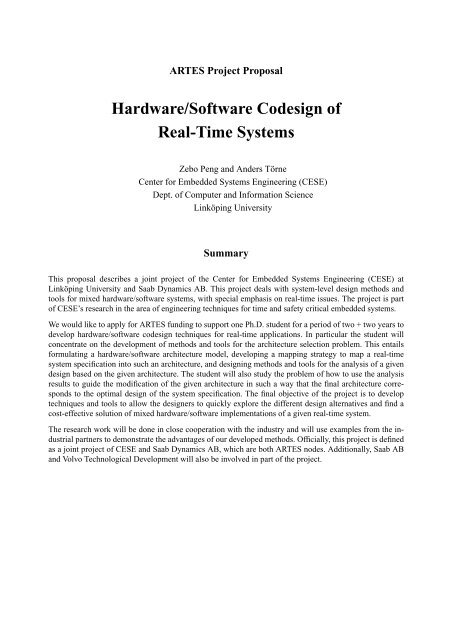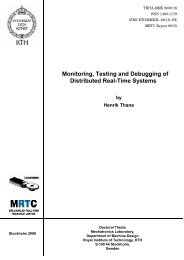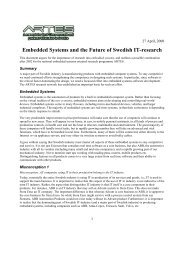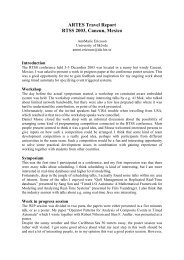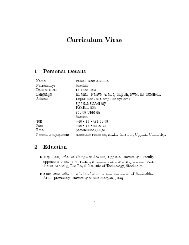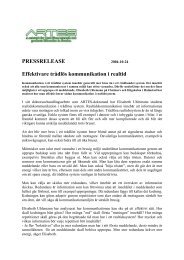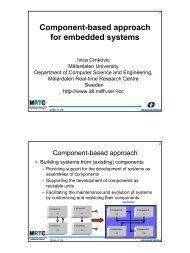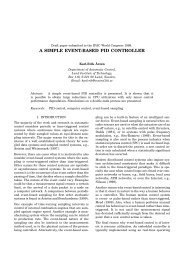Hardware/Software Codesign of Real-Time Systems - Artes
Hardware/Software Codesign of Real-Time Systems - Artes
Hardware/Software Codesign of Real-Time Systems - Artes
Create successful ePaper yourself
Turn your PDF publications into a flip-book with our unique Google optimized e-Paper software.
ARTES Project Proposal<br />
<strong>Hardware</strong>/<strong>S<strong>of</strong>tware</strong> <strong>Codesign</strong> <strong>of</strong><br />
<strong>Real</strong>-<strong>Time</strong> <strong>Systems</strong><br />
Zebo Peng and Anders Törne<br />
Center for Embedded <strong>Systems</strong> Engineering (CESE)<br />
Dept. <strong>of</strong> Computer and Information Science<br />
Linköping University<br />
Summary<br />
This proposal describes a joint project <strong>of</strong> the Center for Embedded <strong>Systems</strong> Engineering (CESE) at<br />
Linköping University and Saab Dynamics AB. This project deals with system-level design methods and<br />
tools for mixed hardware/s<strong>of</strong>tware systems, with special emphasis on real-time issues. The project is part<br />
<strong>of</strong> CESE’s research in the area <strong>of</strong> engineering techniques for time and safety critical embedded systems.<br />
We would like to apply for ARTES funding to support one Ph.D. student for a period <strong>of</strong> two + two years to<br />
develop hardware/s<strong>of</strong>tware codesign techniques for real-time applications. In particular the student will<br />
concentrate on the development <strong>of</strong> methods and tools for the architecture selection problem. This entails<br />
formulating a hardware/s<strong>of</strong>tware architecture model, developing a mapping strategy to map a real-time<br />
system specification into such an architecture, and designing methods and tools for the analysis <strong>of</strong> a given<br />
design based on the given architecture. The student will also study the problem <strong>of</strong> how to use the analysis<br />
results to guide the modification <strong>of</strong> the given architecture in such a way that the final architecture corresponds<br />
to the optimal design <strong>of</strong> the system specification. The final objective <strong>of</strong> the project is to develop<br />
techniques and tools to allow the designers to quickly explore the different design alternatives and find a<br />
cost-effective solution <strong>of</strong> mixed hardware/s<strong>of</strong>tware implementations <strong>of</strong> a given real-time system.<br />
The research work will be done in close cooperation with the industry and will use examples from the industrial<br />
partners to demonstrate the advantages <strong>of</strong> our developed methods. Officially, this project is defined<br />
as a joint project <strong>of</strong> CESE and Saab Dynamics AB, which are both ARTES nodes. Additionally, Saab AB<br />
and Volvo Technological Development will also be involved in part <strong>of</strong> the project.<br />
- 0 -
1. Introduction and Problem Statement<br />
Embedded systems make use <strong>of</strong> both <strong>of</strong>f-the-shelf microprocessors and ASICs to implement specialized<br />
functions [Cam96]. They have a very wide range <strong>of</strong> applications, including process control and computerintegrated<br />
manufacturing systems, transportation systems (automotive control, train control, ship control,<br />
and traffic control), avionics systems, missile control systems, telephone and communications systems,<br />
medical instruments, and different microcomputer-controlled domestic appliances. Such systems consist,<br />
by their nature, <strong>of</strong> both s<strong>of</strong>tware and hardware components [Wol94].<br />
The development <strong>of</strong> such systems requires special design techniques to integrate electrical engineering,<br />
computer engineering, and s<strong>of</strong>tware engineering. Integration is essential for the optimization and management<br />
<strong>of</strong> the complexity <strong>of</strong> embedded systems, the manifold interactions between the subsystems and evolutionary<br />
maintenance <strong>of</strong> reliable systems with adequate cost and performance. The creation <strong>of</strong> the Center<br />
for Embedded <strong>Systems</strong> Engineering (CESE) recently at Linköping University is an effort to combine research<br />
strengthens in several disciplinary areas to deal with the heterogeneous nature <strong>of</strong> embedded systems<br />
engineering. CESE consists currently <strong>of</strong> two research laboratories: ESLAB (Embedded <strong>Systems</strong> Laboratory)<br />
and RTSLAB (<strong>Real</strong>-<strong>Time</strong> <strong>Systems</strong> Laboratory) and its main mission is to develop engineering techniques<br />
for time and safety critical embedded systems. CESE is running several research projects in this<br />
area, which are sponsored by NUTEK and the swedish industry.<br />
The aim <strong>of</strong> the joint project described in this proposal is to develop hardware/s<strong>of</strong>tware codesign techniques<br />
for real-time applications. This is related to the common characteristics <strong>of</strong> embedded systems, namely that<br />
they must behave correctly both in terms <strong>of</strong> function and timing. In order to guarantee that both the function<br />
and timing <strong>of</strong> an embedded system is correct, extensive validation and verification is needed through<br />
out the whole design and development process. Currently, much <strong>of</strong> this is done using traditional s<strong>of</strong>tware<br />
testing and hardware simulation methods, but these are known to be both inefficient and error prone<br />
[Cam96]. Further, these methods can only be efficiently used in the later stages <strong>of</strong> the design process when<br />
the detailed design has mostly been done. This results in a situation that the early design decisions, such as<br />
architecture selection, hardware/s<strong>of</strong>tware partitioning, scheduling, etc., which have high impact on the timing<br />
characteristics and cost <strong>of</strong> the final implementation, are made based on inadequate analysis <strong>of</strong> the designed<br />
system. Therefore, many problem are created early and discovered late when traditional methods<br />
are used. And it becomes very difficult to predict the time and cost <strong>of</strong> development, since the discovery <strong>of</strong><br />
a problem in the testing and simulation phase can lead to major revisions <strong>of</strong> earlier stages in the design.<br />
This project is intended to remedy the problems described above by developing a systematic design method<br />
for real-time systems consisting <strong>of</strong> both hardware and s<strong>of</strong>tware components. Our main emphasis will be<br />
on architecture selection and tools to support design space exploration in the early design phases.<br />
2. Objectives and Research Issues<br />
Our ultimate objective is to develop a real-time system design environment which consists <strong>of</strong> a set <strong>of</strong> integrated<br />
design methods and tools to allow designers to quickly explore the design space and to produce optimized<br />
implementations. Such a design environment is illustrated in Figure 1 and originally proposed in<br />
[Axe97b]. The basic idea is to allow designers to start the design process with a system specification which<br />
does not prescribe the implementation details, such as what to be implemented in hardware and what to be<br />
implemented in s<strong>of</strong>tware. The system specification will then be mapped into a hardware/s<strong>of</strong>tware architecture<br />
model to allow efficient analysis <strong>of</strong> design parameters. The analysis results will be used to guide the<br />
selection or improvement <strong>of</strong> the implementation architecture, partitioning and scheduling.<br />
The main features <strong>of</strong> the proposed design environment are as follows.<br />
• It will deal with earlier design phases, and increase the predictability <strong>of</strong> both the design process and the<br />
operation <strong>of</strong> embedded real-time systems.<br />
• It will provide a framework to allow the designers to find more cost effective and reliable implementations.<br />
• It will provide tools to support the designers and shorten the time to market.<br />
- 1 -
System<br />
Specification<br />
Analysis model<br />
Comp<br />
Lib<br />
<strong>Hardware</strong>/<br />
<strong>S<strong>of</strong>tware</strong><br />
Architecture<br />
Architecture<br />
Selection<br />
Partitioning<br />
Implementation<br />
Scheduling<br />
Figure 1. The proposed design environment.<br />
The basic idea <strong>of</strong> the design environment discussed here and some theoretical results have been already developed<br />
and documented in Jakob Axelsson’s Ph.D. thesis [Axe97b]. However, there are several research<br />
issues which remain to be solved and will be the main focus <strong>of</strong> the proposed project:<br />
Specification techniques<br />
We need to develop or select a specification formalism to support high-level and uniform specification <strong>of</strong><br />
functionality and real-time requirements. The specification formalism should allow the analysis <strong>of</strong> a specification<br />
on a wide range <strong>of</strong> architecture models.<br />
Heterogeneous architecture model<br />
An essential component <strong>of</strong> the design environment is an architecture model to precisely capture the basic<br />
design structures developed typically at the early stages <strong>of</strong> the design process. Such a model should support<br />
the specification <strong>of</strong> the number and type <strong>of</strong> micro-processor, the ASICs and their features, memory,<br />
FPGAs, dedicated controllers, buses and the interconnect structure as well as the basic architecture for the<br />
ASICs. Different architecture models can be developed to fit into different application areas. For example,<br />
a distributed architecture model can be useful for some type <strong>of</strong> embedded systems while a centralized architecture<br />
can be more useful for the others.<br />
One focus <strong>of</strong> our research will be on architecture models which are based on distributed network. Such architectures<br />
are widely used in automotive control and avionics systems as well as process control environments<br />
in the industry. And research in the co-design area, including [Axe97b], has neglected the issues<br />
related to distributed network. It is therefore very important to develop architecture models to support the<br />
analysis and design <strong>of</strong> real-time systems based on distributed networks. We will work closely with the industrial<br />
partners to develop such architecture models based on real-life industrial designs.<br />
Analysis procedures<br />
To be able to automate certain design activities, e.g. architecture selection and partitioning, it is essential to<br />
have good analysis procedures which can be used to predict the results <strong>of</strong> different alternative design decisions.<br />
Since the behavioral description <strong>of</strong> a real-time application normally contains several parallel tasks,<br />
the analysis must take into account the scheduling <strong>of</strong> tasks, i.e. how they share the hardware resources over<br />
time. Therefore, considerable effort has been put into developing flexible scheduling models for heterogeneous<br />
architectures, and a schedulability measurement which indicates how well a proposed design will<br />
meet its real-time constraints has been developed in [Axe95] [Axe97a]. The evaluation <strong>of</strong> the schedulability<br />
measurement requires that certain characteristics <strong>of</strong> a design, e.g. hardware area and execution time <strong>of</strong><br />
different parts, can be estimated, and for this we need to develop analysis techniques and tools that can be<br />
applied to a wide range <strong>of</strong> architectures, including architectures which are based on distributed networks.<br />
- 2 -
Synthesis<br />
Once an analysis technique has been established, which can give indications about the quality <strong>of</strong> a proposed<br />
implementation, we can use this to automatically synthesize a good design. At Linköping University,<br />
we have developed several synthesis algorithms for the hardware/s<strong>of</strong>tware partitioning problem<br />
[Axe96] [Axe97c] [Ele96] [Ele97]. In [Axe96], for example, a branch-and-bound algorithm which assigns<br />
tasks to processors and ASICs in the hardware architecture is described. In the proposed project, we can<br />
extend the existing tools <strong>of</strong> ours with further synthesis capabilities, especially for architecture synthesis,<br />
where different architectures are automatically generated from a set <strong>of</strong> hardware and s<strong>of</strong>tware components.<br />
Design re-use<br />
Another important issue <strong>of</strong> the proposed research is to support incremental design and re-use <strong>of</strong> existing<br />
sub-systems. This means that we must have an efficient way <strong>of</strong> capturing existing sub-systems in the architecture<br />
model and develop techniques to perform incremental analysis <strong>of</strong> a design without having to start<br />
from scratch. Design re-use is an important issue for industrial application, since most <strong>of</strong> the designs in the<br />
industry are based on existing systems.<br />
3. Expected Long-Term Results<br />
The expected results <strong>of</strong> our research in the long run are:<br />
• A formal notation for heterogeneous architecture, which can be executed or simulated.<br />
• A technique to analyze execution time and implementation cost <strong>of</strong> a real-time system specification on<br />
different architectures, with emphasis on architectures based on distributed networks.<br />
• A method to use the analysis results to support trade-<strong>of</strong>fs between different architecture alternatives,<br />
e.g., s<strong>of</strong>tware v. ASICs, different processors, and centralized v. distributed interconnect structure.<br />
• A technique to support optimal architecture selection by formulating it as an optimization problem. Development<br />
<strong>of</strong> some heuristics to solve the combinatorial optimization problem.<br />
The final result will be a coherent methodology for hardware/s<strong>of</strong>tware co-design for embedded real-time<br />
applications and prototype support tools, which will be demonstrated with industrial examples.<br />
4. Project Plan for the First Two Years<br />
The main research <strong>of</strong> the project will be carried out by a Ph.D. student who is a member <strong>of</strong> CESE, with active<br />
involvement <strong>of</strong> Saab Dynamics which participates in the formulation <strong>of</strong> the problems, selection <strong>of</strong> industrial<br />
examples to be used as test cases, and evaluation <strong>of</strong> the results. The student is planned to spend 3<br />
months in Saab Dynamics in a mobility program to get a better understanding <strong>of</strong> the problems in the industrial<br />
environment.<br />
The main tasks to be executed in the first two years (Jan 1998 to Dec. 1999) are:<br />
• Select a system specification language suitable for embedded real-time applications. This task will be<br />
carried out in connection to our research activity in System Specification which is currently sponsored<br />
by SSF.<br />
• Develop a modeling technique for heterogeneous architecture, focusing on issues related to distributed<br />
networks. This will be the main research topic for the first year.<br />
• Select and implement a partitioning algorithm for task allocation. This will be done based on some <strong>of</strong><br />
our earlier research results and in connection to the COCODES project at ESLAB on hardware/s<strong>of</strong>tware<br />
codesign which is sponsored by NUTEK’s Embedded <strong>Systems</strong> program.<br />
• Develop a technique for the analysis <strong>of</strong> execution time <strong>of</strong> tasks on different architectures.<br />
• Develop rules to use the analysis result to manually modify the architecture.<br />
The relation between the different activities <strong>of</strong> the first two years can be visualized in Figure 2. After the<br />
first two years, the results will be documented in the student’s Lic. thesis. During the additional two years,<br />
the student will develop mainly a technique to automate the architecture modifications and synthesis pro-<br />
- 3 -
Specification<br />
Requirement<br />
Task allocation<br />
Analysis<br />
HW/SW<br />
Architecture<br />
Modify<br />
Figure 2. The main tasks <strong>of</strong> the first two years.<br />
cedure, replacing the person illustrated in Figure 2.<br />
5. Preliminary Budget<br />
The preliminary yearly budget is calculated as follows:<br />
Ph.D. Student, 80%<br />
Supervisors (Peng, Törne), 10%<br />
Computer and equipment<br />
Travel<br />
Administration and <strong>of</strong>fice<br />
Total budget per year:<br />
300.000 SEK<br />
70.000 SEK<br />
50.000 SEK<br />
30.000 SEK<br />
50.000 SEK<br />
500.000 SEK<br />
The project will last for 2 + 2 years.<br />
6. CESE and Research Cooperation<br />
This project is part <strong>of</strong> an effort to develop engineering techniques for time and safety critical embedded<br />
systems at CESE. CESE consists currently <strong>of</strong> ESLAB and RTSLAB at the Department <strong>of</strong> Computer and<br />
Information Science (IDA) which has extensive experience <strong>of</strong> research on real-time systems, formal methods<br />
and hardware/s<strong>of</strong>tware codesign. One <strong>of</strong> the aims <strong>of</strong> the center is to make this competence available to<br />
the industry, and to develop it in directions which are <strong>of</strong> strategic importance. In particular, ESLAB’s main<br />
research focuses on the development <strong>of</strong> design and test methodologies and tools for embedded systems, especially<br />
those which consist <strong>of</strong> tightly coupled hardware and s<strong>of</strong>tware subsystems. RTSLAB, on the other<br />
hand, has a broad competence in the design <strong>of</strong> embedded s<strong>of</strong>tware systems. ESLAB is also involved in EC-<br />
SEL at Linköping University which is sponsored by SSF.<br />
Both ESLAB and RTSLAB have involved and are participating currently in several cooperation projects<br />
covering a wide spectrum <strong>of</strong> research areas. Some <strong>of</strong> these projects, which are closely related to the proposed<br />
research, are summarized as follows.<br />
<strong>Hardware</strong>/s<strong>of</strong>tware codesign. ESLAB has been involved in a joint research project (COCODES), together<br />
with the Electronic System Design Lab at KTH, Synthesia AB, Ericsson Telecom, and Saab Dynamics,<br />
which is sponsored by NUTEK’s Embedded <strong>Systems</strong> program. The project aims at the development <strong>of</strong> a<br />
design environment for embedded systems consisting <strong>of</strong> hardware and s<strong>of</strong>tware components and are control<br />
and communication dominated. Based on an evaluation model, a specified system is partitioned into<br />
hardware and s<strong>of</strong>tware domains and implementation details are added. We are also developing techniques<br />
to support re-partitioning and to handle changes in design requirements or <strong>of</strong> technology.<br />
Application level programming <strong>of</strong> control systems. RTSLAB is involved in ISIS, a competence center for<br />
“information systems for integrated supervision and control”, together with several other researcher groups<br />
at Linköping University and ABB Industrial <strong>Systems</strong>, ABB Robotics, Ericsson Utvecklings AB, Saab Au-<br />
- 4 -
tomobile, Saab Dynamics, Saab AB, etc. The overall goal <strong>of</strong> ISIS is to provide competence that is useful<br />
for the design <strong>of</strong> complex industrial systems related to control and supervision. RTSLAB has also a past<br />
experience with multi-level architectures for process control.<br />
Timing and functional analysis <strong>of</strong> embedded s<strong>of</strong>tware systems. A Petri-net representation has been developed<br />
for capturing the sensing and control <strong>of</strong> a physical environment jointly by RTSLAB and ESLAB. The<br />
models are timed and the intention is to describe the controller and the controlled system using different<br />
model languages to achieve reusability, decomposition, and modularity. The models are automatically generated<br />
from process control s<strong>of</strong>tware or system designs, and can be used for timing analysis <strong>of</strong> real time<br />
and process control system designs. In particular this is applied to systems described by process control<br />
languages. Process control languages are application specific high level languages, tailored for describing<br />
process control systems. At RTSLAB we have studied both standard process control languages and extensions,<br />
methods for error recovery and the integration <strong>of</strong> database technology in process control systems.<br />
Studies have also been made on how to achieve an engineering method, given end to end timing requirements<br />
on the system, which generates a reliable design <strong>of</strong> computational tasks in a fixed priority framework<br />
satisfying these requirements.<br />
System engineering methods. RTSLAB participates in a larger European project which involves major<br />
aerospace industries. The project will develop a new standard for exchange <strong>of</strong> design data. RTSLAB’s part<br />
is to develop the data model for design data. The scope <strong>of</strong> the project is the system development process -<br />
system requirement and functional analysis, and physical architecture design. The relevant tools for generating<br />
the design data are, e.g., Statemate, RDD-100, Core, MatrixX etc. Related to this is a project developing<br />
methods and tools for supporting the development and inspection process <strong>of</strong> s<strong>of</strong>tware. By taking<br />
well known academic methods for verification and modifying them to be more suitable for engineering<br />
use, a method for supporting the inspection process has been developed. In relation to the focus <strong>of</strong> CESE<br />
this competence gives valuable insights into the industrial system development process, where the modelling<br />
and design tools mentioned earlier are to be used. The main industrial partners in the activities above<br />
are Saab Aerospace, Saab Dynamics and ABB Industrial <strong>Systems</strong>.<br />
7. Industrial Cooperation<br />
The main industrial partner <strong>of</strong> this project is Saab Dynamics AB. It has participated in the formulation <strong>of</strong><br />
the research direction and identification <strong>of</strong> the main research issues <strong>of</strong> the project and will be involved partially<br />
in the execution <strong>of</strong> the research as well as its case studies and evaluations. The other industrial partners<br />
in the project, Saab AB and Volvo Technological Development, will be involved mainly in the<br />
problem formulation and evaluation part <strong>of</strong> the project. All industrial partners will be invited regularly to<br />
project meetings and will receive project reports and publications. The contact persons from the three companies<br />
will form a reference group <strong>of</strong> the project.<br />
Contact information for the industrial partners is as follows:<br />
Company Contact Person(s) E-mail Telephone Address<br />
Saab Dynamics<br />
Helge Persson<br />
Åke Johansson<br />
helpe@weald<br />
.air.saab.se<br />
Saab AB Dag Folkesson dagfo@weald<br />
.air.saab.se<br />
Volvo<br />
Technological<br />
Development<br />
Jakob Axelsson<br />
jaax@vtd<br />
.volvo.se<br />
013-186200 Saab Dynamics AB<br />
581 88 Linköping<br />
013-181855 Saab AB<br />
581 88 Linköping<br />
031-7724389 AB Volvo, Technological<br />
Development<br />
Chalmers Teknikpark<br />
412 88 Göteborg<br />
- 5 -
List <strong>of</strong> Appendices to the project “<strong>Hardware</strong>/<strong>S<strong>of</strong>tware</strong> <strong>Codesign</strong> <strong>of</strong> <strong>Real</strong>-<strong>Time</strong> <strong>Systems</strong>”<br />
1. References.<br />
2. Short resume <strong>of</strong> Pr<strong>of</strong>. Zebo Peng.<br />
3. Short resume <strong>of</strong> Dr. Anders Törne.<br />
4. Supporting letter from Saab Dynamics.<br />
5. Supporting letter from Volvo Technological Development.<br />
6. Supporting letter from Saab AB will be sent in a separate envelop.<br />
References<br />
[Axe95]<br />
[Axe96]<br />
[Axe97a]<br />
[Axe97b]<br />
[Axe97c]<br />
[Cam96]<br />
[Ele96]<br />
[Ele97]<br />
[Wol94]<br />
J. Axelsson, "Analysis and Improvement <strong>of</strong> Task Schedulability in <strong>Hardware</strong>/<strong>S<strong>of</strong>tware</strong> <strong>Codesign</strong>,"<br />
Proc. 7th Euromicro Workshop on <strong>Real</strong>-<strong>Time</strong> <strong>Systems</strong>, pp. 276-283, Odense, June 14-<br />
16, 1995.<br />
J. Axelsson, "<strong>Hardware</strong>/<strong>S<strong>of</strong>tware</strong> Partitioning Aiming at Fulfilment <strong>of</strong> <strong>Real</strong>-<strong>Time</strong> Constraints,"<br />
Journal <strong>of</strong> <strong>Systems</strong> Architecture 42(6-7):449-464, 1996.<br />
J. Axelsson, "A Portable Model for Predicting the Size and Execution <strong>Time</strong> <strong>of</strong> Programs,"<br />
Journal <strong>of</strong> <strong>Systems</strong> Architecture 43(1-5):211-213, 1997.<br />
J. Axelsson, "Analysis and Synthesis <strong>of</strong> Heterogeneous <strong>Real</strong>-time <strong>Systems</strong>," Ph.D. Dissertation,<br />
Linköping University, Sweden, 1997.<br />
J. Axelsson, "Architecture Synthesis and Partitioning <strong>of</strong> <strong>Real</strong>-<strong>Time</strong> <strong>Systems</strong>: A Comparison <strong>of</strong><br />
Three Heuristic Search Strategies," Proc. 5th International Workshop on <strong>Hardware</strong>/<strong>S<strong>of</strong>tware</strong><br />
Co-Design, pp. 161-165, Braunschweig, March 24-26, 1997.<br />
R. Camposano and J. Wilberg, "Embedded System Design," Journal on Design Automation for<br />
Embedded <strong>Systems</strong>, Vol. 1, pp.5-50, 1996<br />
P. Eles, Z. Peng, K. Kuchcinski and A. Doboli, "<strong>Hardware</strong>/<strong>S<strong>of</strong>tware</strong> Partitioning with Iterative<br />
Improvement Heuristics", Proc. 9th International Symposium on System Synthesis (ISSS'96),<br />
La Jolla, California, Nov. 6-8, 1996.<br />
P. Eles, Z. Peng, K. Kuchcinski and A. Doboli, "System Level <strong>Hardware</strong>/<strong>S<strong>of</strong>tware</strong> Partitioning<br />
Based on Simulated Annealing and Tabu Search," Journal on Design Automation for Embedded<br />
<strong>Systems</strong>, Vol. 2, pp.5-32, 1997.<br />
W. H. Wolf, "<strong>Hardware</strong>/<strong>S<strong>of</strong>tware</strong> Co-Design <strong>of</strong> Embedded <strong>Systems</strong>," Proceedings <strong>of</strong> the IEEE,<br />
82(7):967-989, 1994.<br />
- 6 -


